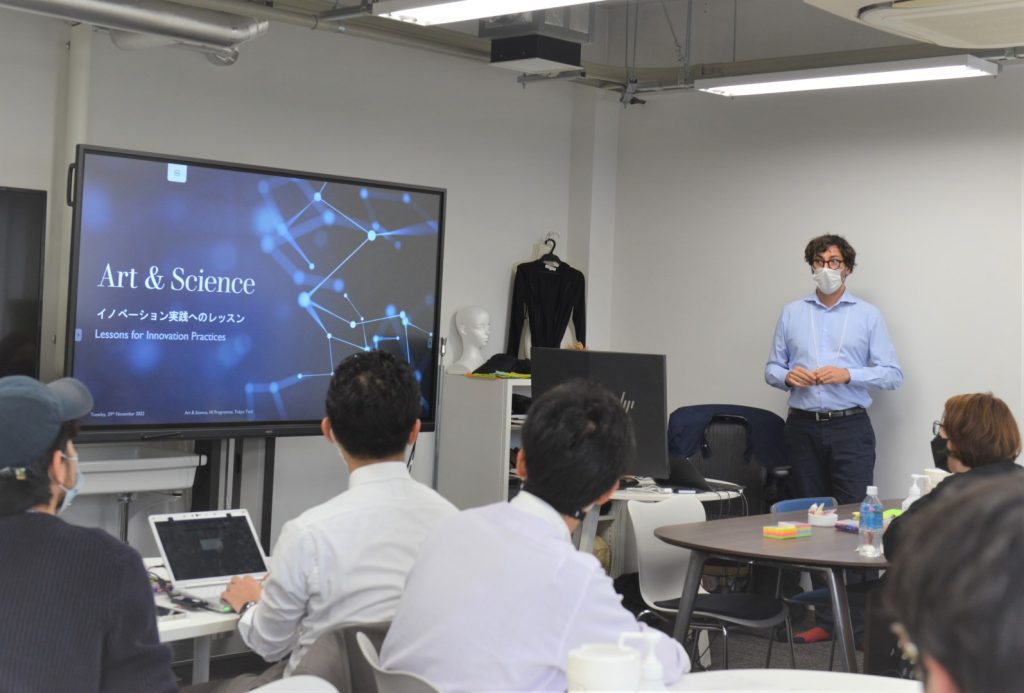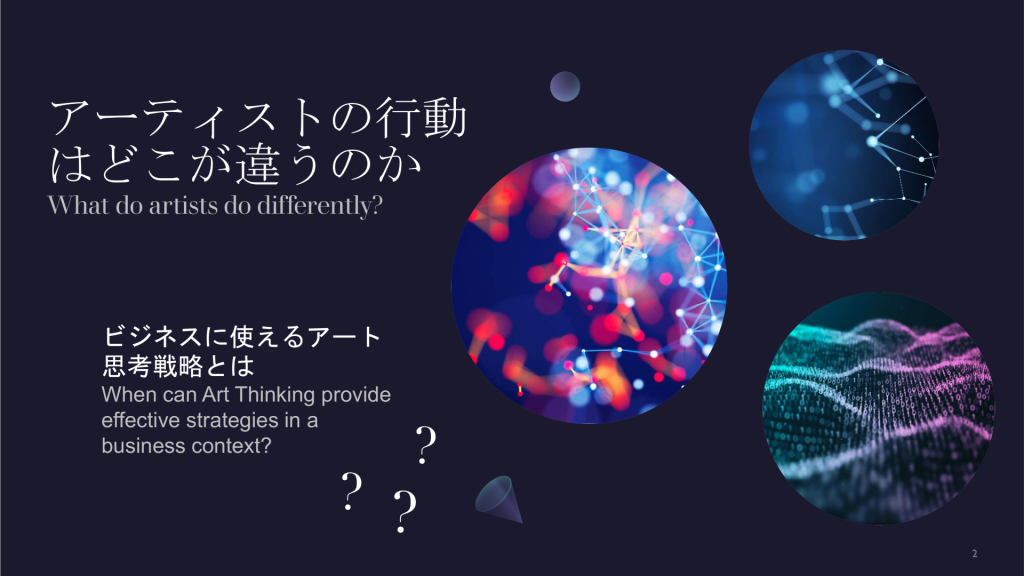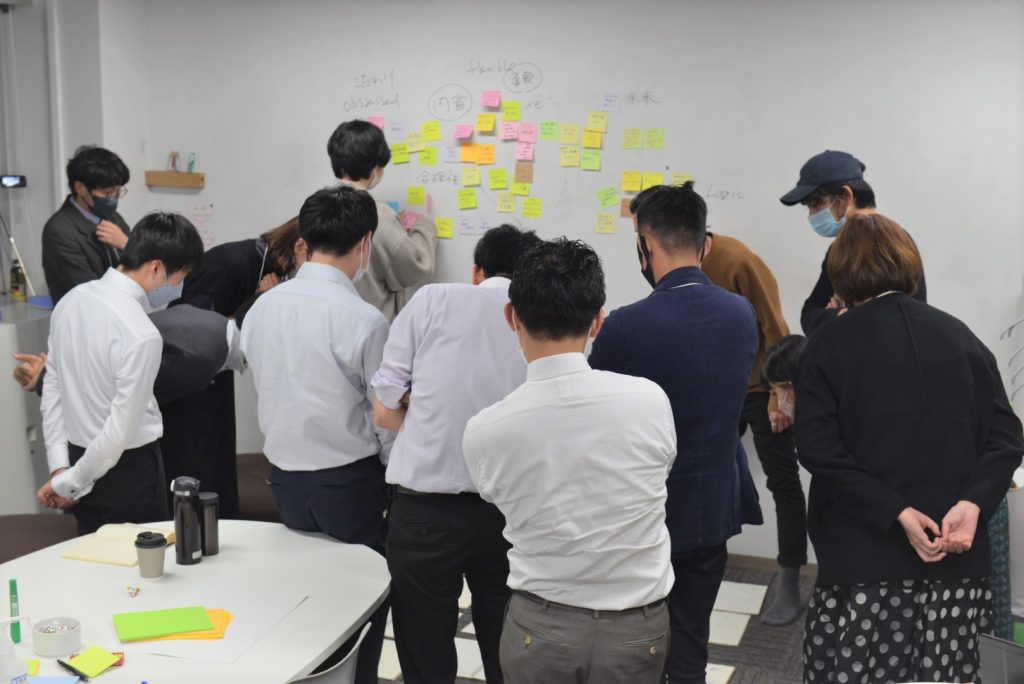2022年11月29日、産学連携ハイブリッド・イノベーションプログラム第4回セッションを開催しました。HIクリエイティブ・ディレクターのジョルジオ・サラニ特任助教がイノベーション実践におけるアート思考について講義し、今回はHI実践プロジェクト(全3回)を開始しました。スタッフチームとしては、HIディレクターの野原教授が通訳を担当、アシスタント・ディレクターの鹿又亘平氏がファシリテーターを務めました。

セッション前半は、前回で質問や意見が集中した2つの問題を掘り下げました:アート、アート思考とは何を意味するのか、そしてそのどのようなテクニックや概念が、ビジネスの文脈に有益なのか。そこで西洋美術史から例をとり、アートと科学間の、根本的な違いを探ります。例えばクリストとジャン・クロードによるインスタレーションを観ると、同じ構造物を厳格な設計方法論で制作する場合も、アーティスト、デザイナー、エンジニアでは目指すものが違っていることがわかります。同様に著名な西洋のアーティストの作品から、合理的・論理的・さらには非論理的な思考にアートの特徴があることが指摘されました。さらにアートと科学において曖昧さが果たす役割、「センス・メイキング」と「意思決定」の区別、アート活動における内省の重要性(社会科学とも共通)も挙げられました。

アート思考を用いたイノベーションプラットフォームは多々ありますが、それらを学際的に統合した東工大のHI手法の特徴にもここで言及しています。
こうした理論的フレームワークを、後半の実技で体験していただきました。直感を大事にするスケッチングは、参加者個々人の目標や専門知識を洗い出していきます。その視覚化された情報をもとに共通概念を探してグループ分けをし、HI践プロジェクトに向けた第一歩を踏み出しました。HI実践プロジェクトでは、グループごとに特定のテーマをめぐって何らかの「介入(intervention)」に取り組んでいただきます。作るものは製品、サービス、アート作品など何でもあり、デジタルでもリアルでも、モデル提示でも刺激的な問題提起でもOKです。自分が描いた絵を見てまず自己否定するのではなく、まずは素早く多様なアイデアを生み出すことを目指し、スケッチによるアイデア出しを行いました。出たアイデアは次のセッションに引き継がれ、最終的な提案へと展開していきます。最終的には、アウトプットは科学とアートの融合的アプローチによる議論を経て、2023年4月に開催されるHIシンポジウムで公開される予定です(日程は未定)。

次回のHIセッションは、12月13日(火)にロンドン芸術大学セントラル・セント・マーチンズ校のデザイン理論家/哲学者であるベティ・マレンコ博士を招聘し開催します。講義・インタラクティブワークショップともに英語で開催、日本語への同時翻訳も提供します。
HI 2022 活動期間:2022年10月~2023年4月
プログラム内容:対面とオンラインを柔軟に取り入れたセミナー、ワークショップ、ものづくり、実験、クリエイティブコミュニティ活動など。 参加企業によるグループプロジェクトの成果を公開する最終シンポジウムが、2023 年 4 月に予定されています。
手法・昨年のプログラムなど、さらなる情報が欲しい方はこちら: https://www.tse.ens.titech.ac.jp/~deepmode/csm/blog/未来を創るhybrid-innovation/
お問い合わせは事務局へ: ogiuchi.s.aa[@半角に変更してください]m.titech.ac.jp あるいは tokyotechxcsm@tse.ens.titech.ac.jp
過去のセッション1、セッション2の記事はこちらからご覧いただけます。
The fourth session of our Hybrid Innovation programme for Japanese industry was held at Nohara Lab on 29th November 2022. HI Creative Director Dr Giorgio Salani led the session with a lecture on Art Thinking in innovation practice and kickstarted the first of three HI Practice sessions focusing on group work. The staff team includes HI Director Professor Kayoko Nohara – who translated the content to Japanese – and Assistant Director Kohei Kanomata, who facilitated the discussion.

The first half of the session was occupied by a conversation around two key points raised in previous sessions that were wort exploring in more depth: what do we mean by Art Thinking? And, what techniques and notions of Art Thinking can be beneficial in a business context? The lecture in English by Dr Giorgio Salani (Tokyo Tech) employed examples from Western art history to explore fundamental differences between art, science and other practices. For example, an installation by the artists Christo and Jean Claude was introduced to point out the sharp difference in the goals of fine artists, designers and engineers, even when they are working on the same structure and follow a strict design methodology to implement their work. Similarly inspired by various artworks by famous figures in the Western canon, distinctions were raised between rational, logical and even alogical thinking in multiple fields. Other examples include the contrasting role ambiguity plays in the arts and in science, the distinction between “sense-making” and “decision making”, and the importance of reflexivity in art practice (in common with the social sciences).

The lecture also pointed out the difference between purely Art Thinking-based innovation platforms and Tokyo Tech’s Hybrid Innovation approach, which integrates lessons from Art Thinking into a transdisciplinary method. The theories debated in the first half directly informed the practical exercises that were later assigned to the participants. In particular, intuitive sketching offered means to connect with individual goals and specific expertise that each participant was bringing to the group work. Making personal interests and intentions apparent in visual form was used to negotiate the splitting of the team into groups, who will carry over multiple sessions and complete the assignment for the HI Practice together. Informed by transdisciplinary interactive exercises, each group will develop an “intervention” to tackle issues around an assigned broad theme. This can take the form of products, services, artworks or visual representations that can range from fully working models to more speculative/evocative work, in either digital or physical form. The participants started the ideation phase with sketching assignments intended to generate quick and varied ideas without any form of self-censorship. These will be taken on in the next few sessions and will eventually coalesce into the final proposals. The results will be amply discussed in the final sessions using a mixed art/science approach, and presented to the public in the HI Symposium to be held in April 2023 (exact date TBC).

The next session of the HI programme will be held on 13th November December and will see the participation of Dr Betti Marenko, a design theorist and philosopher from Central Saint Martins college, University of the Arts London. The event will be held in person at Tokyo Tech, with an interactive workshop held in English and translated simultaneously into Japanese.
Activity period: October 2022 to April 2023
PROGRAMME CONTENT: Seminars, workshops, manufacturing, experiments, creative community activities, etc. that flexibly use face-to-face and online. A final symposium – open to participating companies and the public – is scheduled for April 2023.
Here you can find our previous posts on Session 1, Session 2 and Session 3
For info please contact: tokyotechxcsm@tse.ens.titech.ac.jp